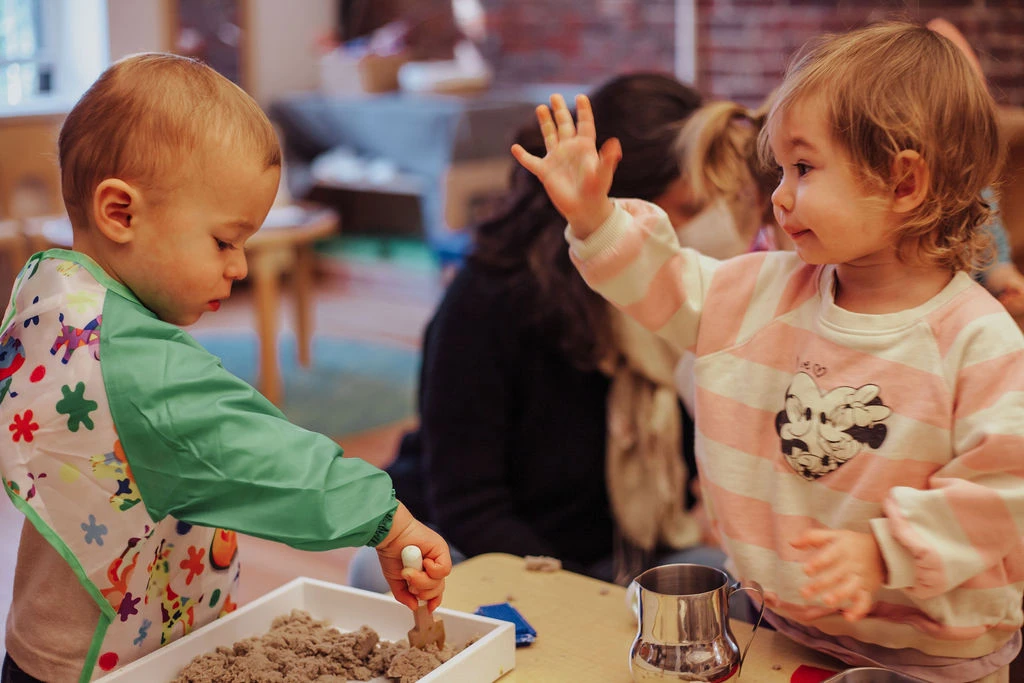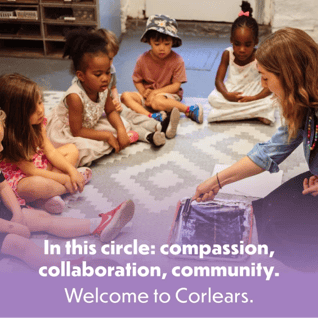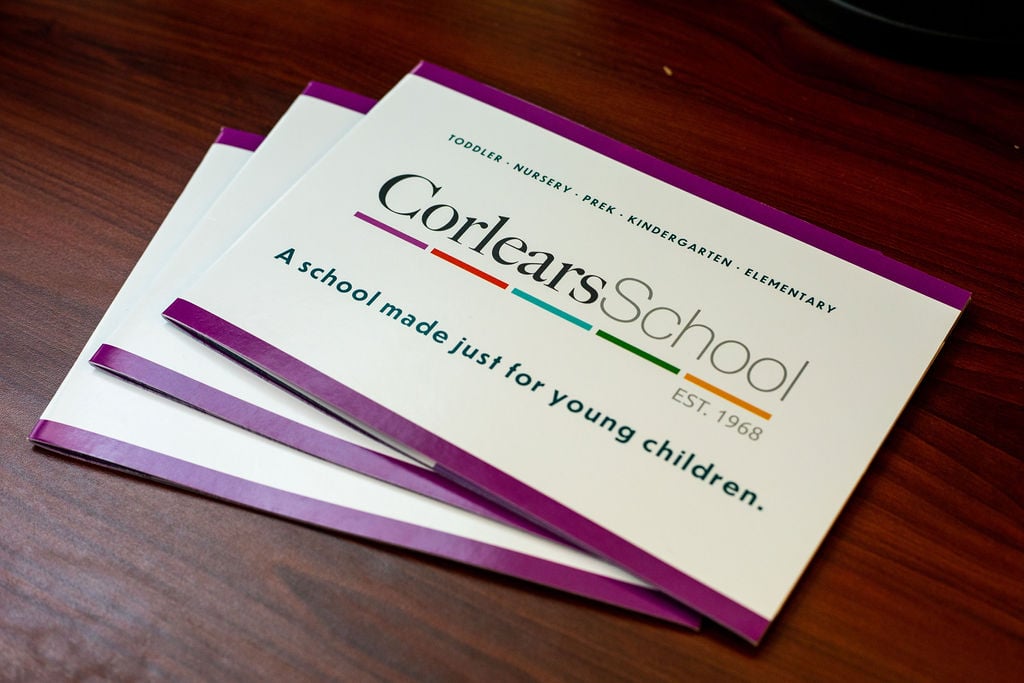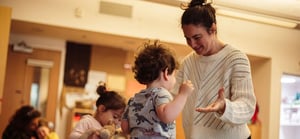Program Overview
The Roots toddler program focuses on the growth of toddlers who are building confidence within new environments. By relying on grown-ups beyond their own family members to meet their needs, toddlers form trusting relationships with their teachers and develop the courage to take play-based leaps beyond their comfort zone. In tandem, toddlers will build security to play with others and develop a sense of belonging to a community. This gentle approach paves the way for healthy separation from the child’s primary caregiver and influences their capacity to build friendships with peers.
The main goals of our Roots class are for your child to feel a sense of comfort, belonging, and independence in their first school environment. The curriculum is rooted in the experience of separating from a loved one and attaching to the classroom teacher. Class begins at 90 minutes, with caregivers working alongside their child and the classroom teacher.
Gradually, caregivers phase out of the classroom space entirely, and students are to confidently stay for the duration of a lengthened drop-off class.
Our class, also called “Gentle Separation,” ensures toddlers ages 16–24 months get a strong start in key developmental areas by:
- Promoting learning through the art of play, in spaces designed intentionally for them
- Creating experiences for children to exercise their natural sense of wonderment within safe, nurturing environments
- Focusing on the power of relationships with peers and benefits of socialization outside of the home

Why Choose Seedlings at Corlears?
Connect with the Admissions Team
Why Choose Corlears?
Our deliberate and constructed curriculum is developmentally driven and designed to foster independence, responsibility, and self-advocacy. Parents and caregivers are supported by our child development-focused educators, compassionately guiding toddlers as they form healthy new attachments.
Toddlers in our Roots classes learn skills related to language, math, science, art, and daily living, while also enhancing fine, gross motor, and sensory development. Every child in our Roots program will have the opportunity to engage in hands-on learning activities, including:
- Physical: Climbing play structures in the yard, running outdoors, jumping, hopping, riding a bike, throwing a ball, dancing, playing in the gym.
- Language, literacy and linguistics: Singing songs, storytelling, rhyming, being read to, writing, drawing.
- Mathematical and scientific thinking: Playing with manipulatives like puzzles, building blocks, play kitchen, counting objects, measuring and comparing sizes, shapes, height and length.
- Social-dramatic play: Responding to and interacting with peers, teachers, and caregivers as they reenact lived experiences and engage in imaginative, dramatic play areas.
- Sensory: Playing with textured objects like sand, water, paint, clay, fabric, and soft climbing structures.
Corlears School's Early Childhood Philosophy

Go Inside the Roots Classroom
A few other skills the children are developing with this experience include gross motor strength (pulling apart the tiles — some are very strong!) and fine motor skills as they manipulate, maneuver, construct, and even deconstruct. Teachers identify and name the colors, shapes, and structures, which encourages language and early literacy development.

As students navigate the rocker board, foam climber, and other structures, they are learning to balance and shift their weight, which requires motor planning, a mind-body connection, and the strength and confidence to use the climber. Repeated exposure to the same experience promotes an increase of stability and fluidity of their movement over time. Children are “drawn toward opportunities that call for problem solving with different areas of their bodies. Children modify their body positions, relocate their centers of gravity and create a sturdy support system with legs and planted feet” (Benson McMullen, M. & Brody, D. [2021]. Infants and Toddlers at Play).

By practicing their hand-eye coordination and using their muscles to manipulate the dough with their hands, the children are also practicing their fine motor skills. Social and emotional skills development may also come into play if, for example, a student wants a tool that someone else has, and they must practice turn-taking. Cognitive development is also promoted as the children are playing and pretending to make various objects.

Moments of language and literacy learning happen all day throughout the Roots classroom, including during snack time, when they have another opportunity to hear a book read aloud. One of the most important ways that educators can support children’s language development is to read to them; the book read during snack time is usually made available for the children to browse on their own after snack time. Hearing teachers read eventually leads to the child's significant and profound understanding that text, symbols, and sounds have meaning. Teachers also encourage the children to notice one another at the snack table and engage them in conversation in this way. Children are asked to communicate verbally when they want more snacks or need help with their water bottle or chair, which sets the expectation that when they use their words, their trusted grown-ups can understand and respond to their needs.

An example of social and emotional learning happens in the dramatic play area, where the children engage in play schemas and playworlds that mirror their lived experiences through play. They cook in the play kitchen, sit at the table for a meal, pretend to eat, care for babies, sweep the floor, open and close doors, and use objects to represent their lifeworld and familial cultures which they bring into the classroom as they create meaningful home-school connections.

2024—25 Roots Tuition
$10,920
Tuition is payable in installments upon request.
$15,600
Tuition is payable in installments upon request.

From the Blog
Literacy at Corlears: Building Strong Foundations for Reading and Writing Success
Differences Between Nursery School and Daycare: What to Consider
Building Social Skills: Teaching Toddlers How to Share
Join the Corlears Community
Interested in enrolling your child at Corlears School? Subscribe to our mailing list to learn more about your program of interest and to receive updates about admissions, campus visits, and other announcements. Or, you can connect directly with the team at admissions@corlearsschool.org.










